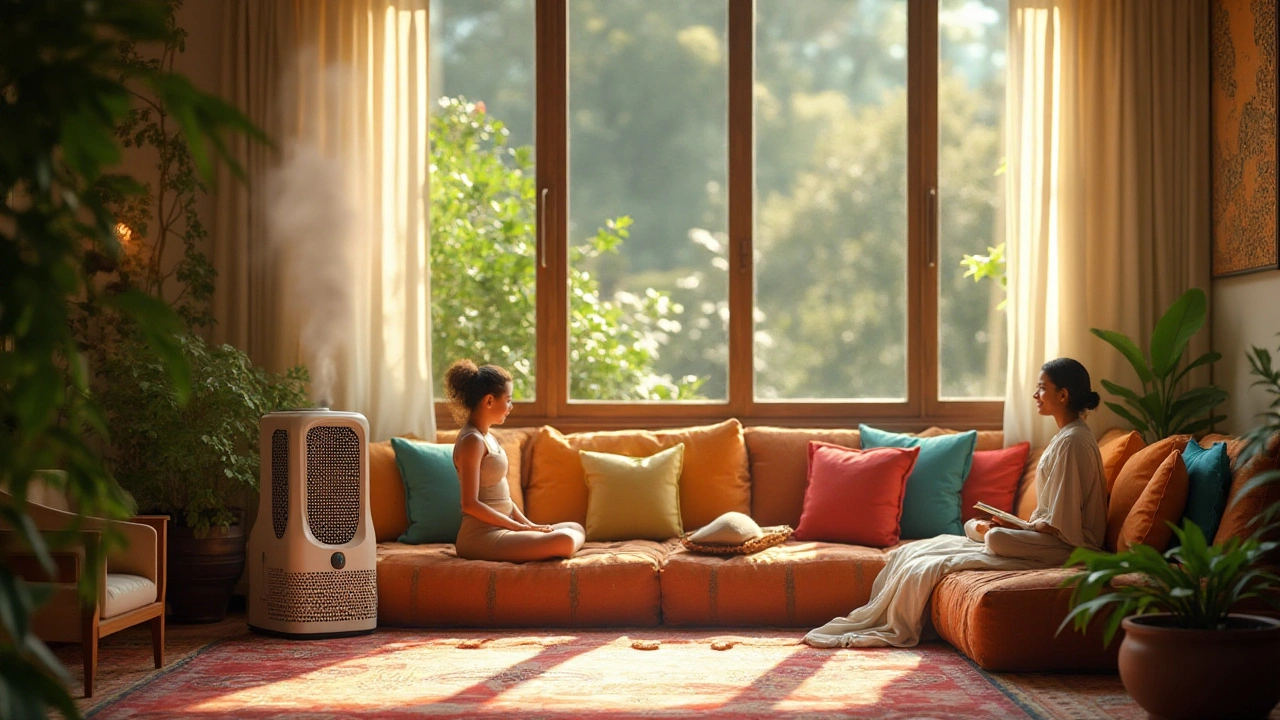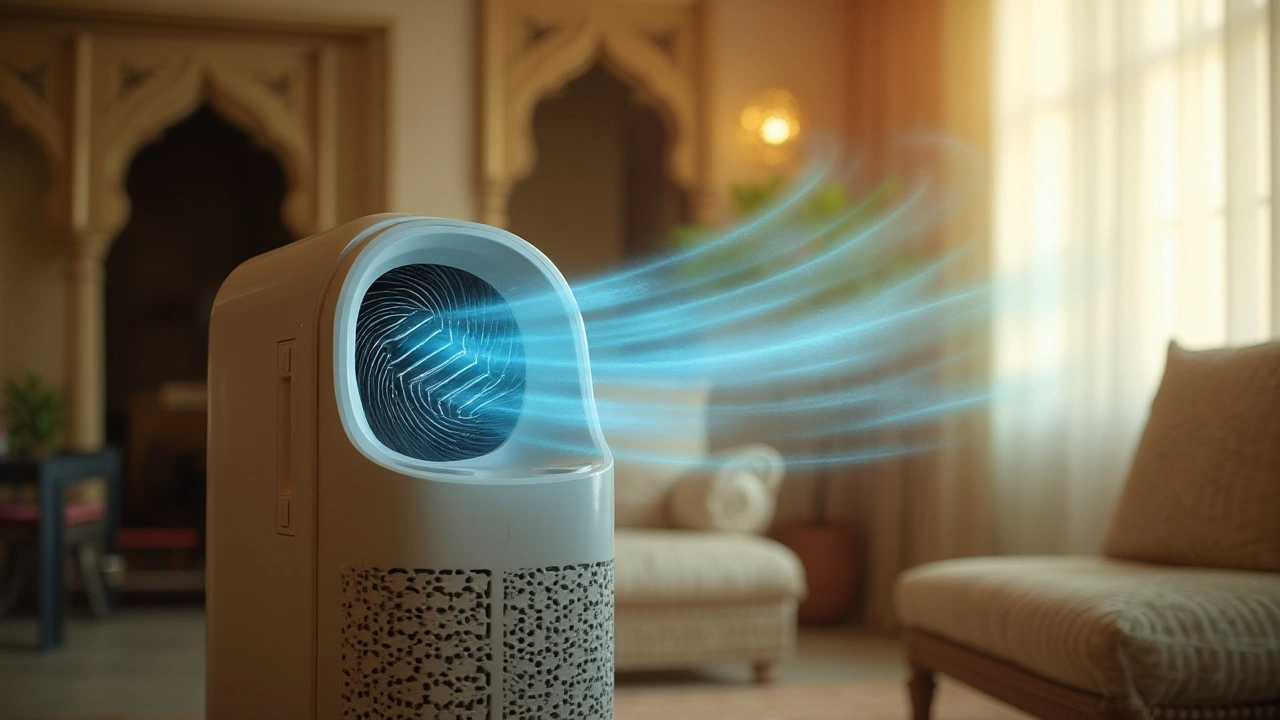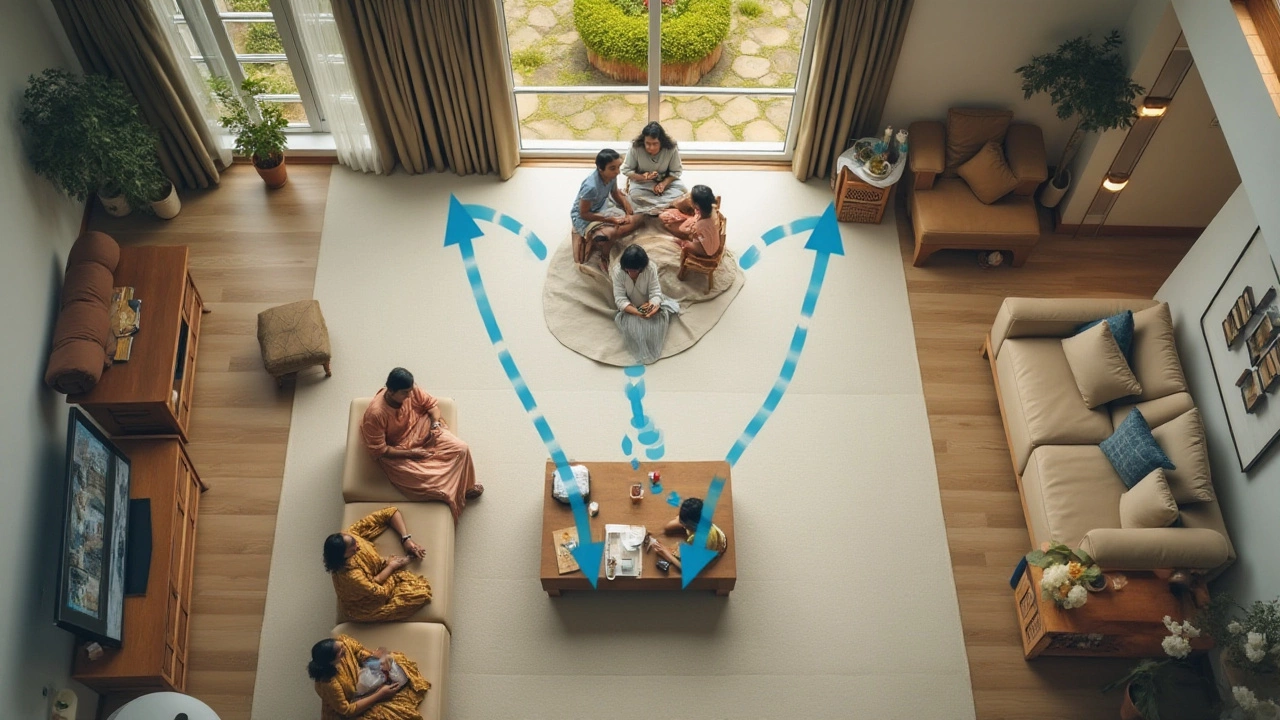
In a world where air quality is a growing concern, air purifiers have become essential gadgets for many households. Yet, a common question arises—how long does it really take for these devices to cleanse a room effectively?
The answer isn't as straightforward as one might think, involving several factors such as the size of the room, type and model of the purifier, and the existing air quality. Each element plays a role in determining just how quickly you're breathing cleaner air.
By investigating the workings of your air purifier and understanding the conditions in your space, you can ensure that you’re making the most of these machines. Dive into this comprehensive guide to start breathing easier and wiser.
- Understanding Air Purifier Functionality
- Factors Affecting Purification Time
- Room Size and Air Circulation
- Types of Air Purifiers and Their Efficiency
- Tips for Maximizing Air Purifier Performance
Understanding Air Purifier Functionality
A journey into the heart of an air purifier reveals the magic that transforms indoor environments, turning what was once a battleground of dust and allergens into spaces of tranquility and safety. The primary function of an air purifier is to cleanse the air by trapping particles, allergens, and pollutants that infiltrate homes through various means. Imagine a fine sieve through which air is drawn, leaving behind invisible foes like pollen, dust, smoke, and pet dander.
This impressive feat is primarily achieved through filtration systems, with the most effective being the High Efficiency Particulate Air (HEPA) filter, renowned for capturing up to 99.97% of particles as small as 0.3 microns. The HEPA magic is not simply a minor feature; it acts as the cornerstone of an air purifier's capability. Activated carbon filters add another layer, tackling odors and volatile organic compounds. According to the Environmental Protection Agency, "these units can help reduce airborne contaminants, including viruses, in a confined space."
To understand an air purifier's level of efficiency, it's useful to consider the technology used and its targeted pollutants. Some devices incorporate ultraviolet (UV) light systems that neutralize biological contaminants like bacteria and viruses, proving vital in comprehensive air cleaning tasks. Emerging technologies like ionizers, which release charged particles, cause pollutants to stick to surfaces and render them less volatile. Such features can significantly enhance air quality but are often met with skepticism due to potential ozone emission concerns, a point for buyers to ponder.
The inner workings extend to the rate of air exchange, known as the Clean Air Delivery Rate (CADR), a pivotal figure in determining how well an air purifier circulates and cleans air within a specified time frame. As per studies, a higher CADR translates to faster air purification, meaning fresher air quicker. Alongside this, noise levels, energy consumption, and size play into how suitable a purifier is for particular environments, balancing the quest for quiet rooms against the might needed for large spaces.
"Choosing the right air filter for your home can markedly improve your quality of life," says Dr. Michael Stuf, a leading researcher in indoor air quality.
To fully appreciate an air purifier's role, envision it as a caretaker, continually cycling indoor air to remove hazardous particles. Its value is underlined by its adaptability in different living conditions, different devices focusing on specific needs alongside general air improvement. Whether you prioritize eliminating smoke or coping with an allergy season, the right air purifier effectively becomes not just an appliance but a pivotal member of the household.
Factors Affecting Purification Time
When considering the efficiency of an air purifier in cleansing a room, multiple critical factors come into play, intertwining to influence how rapidly you can expect fresher air. Central to this is the Clean Air Delivery Rate (CADR), a standard measure reflecting how well a purifier reduces pollutants like dust, smoke, and pollen. The higher the CADR, the quicker your room reaches an improved air quality, making it invaluable for those seeking rapid results. However, CADR isn't a standalone hero; it's influenced by the purifier’s technology and the physical dimensions of your space.
Room size undeniably dictates the purifier’s speed as well, because larger areas naturally demand more time to experience significant changes in air quality. For the best outcomes, match your purifier’s capacity with the room's volume—usually measured in square footage or cubic meters. Say you have a larger living room; opting for a purifier designed for smaller spaces would be akin to expecting a tabletop fan to cool a stadium. Another layer of complexity involves the room’s airflow. Good air circulation facilitates quicker pollutant dispersal and purification, so letting air circulate effectively in and out of the room complements the purifier’s efforts.
Types and efficiency of air filters also determine how swiftly purification takes place. HEPA filters, celebrated for their ability to capture 99.97% of particles as minuscule as 0.3 microns, are significantly efficient but can vary in thickness and construction quality. While they stand out for particulate removal, activated carbon filters excel in eliminating odors and gases, a factor pivotal for those living with smokers or in urban environments. The symbiosis of these filters often leads to better results. Still, maintenance matters; clogged or outdated filters slow down the process regardless of their initial quality, so regular checking and timely replacements are a must for maintaining peak performance.
Ambient air quality before purifier activation profoundly affects the bridge to cleaner air. A room that starts with heavily polluted air will naturally take longer to purify than an already cleaner environment. This concept ties into the local setting; urban areas, prone to automobile and industrial emissions, can strain a purifier more than a rural setting surrounded by greenery. A practical real-life illustration showed that air quality improves significantly in a span of 30 minutes to two hours in most household scenarios, contingent on the aforementioned variables. By anticipating these elements, users can set realistic expectations while also making informed decisions about what configurations suit their needs best.
Contributing to the purification dynamics are often overlooked aspects like humidity levels. Higher humidity may impact some purifying processes by affecting how well filters trap particles, and electrostatic technologies might gather moisture, thereby influencing performance. A comprehensive understanding improves with time spent around your device, personally observing how conditions change across different times of the day or weather patterns. Seasonal changes can also tip the balance, affecting pollutant types and concentrations, a crucial aspect for new users to think about upon installing an air purifier.
As the renowned environmental scientist, Dr. Helen Whitley, once explained, "Understanding air purifiers isn’t about finding an instant fix, but recognizing the delicate dance between technology and environment to deliver clean air effectively." Clean air is not just a product but a continuous pursuit of optimized living standards, made achievable by acknowledging these influential factors and adapting accordingly.

Room Size and Air Circulation
When it comes to understanding how long an air purifier takes to clean a room, one of the paramount factors is the size of the space. The larger the room, the more time it will take for the purifier to cycle through the air completely. This is because air purifiers are designed to handle a specific volume of air within a given period. Typically, the capacity of an air purifier is expressed in the square footage it can effectively cover. Hence, knowing the size of your room in square feet or meters is a critical first step in determining which air purifier will offer the quickest and most efficient room purification.
Sizing Up Your Space
Understanding the dimensions of your room can directly influence the device's performance. For example, a purifier designed for small spaces will struggle in large areas, taking significantly longer to purify the air. Conversely, using a larger unit designed for expansive areas in a small room might seem advantageous, but it can result in unnecessary energy usage, potentially shortening the lifespan of the filter due to overuse.Importance of Air Circulation
In tandem with room size, air circulation plays a critical role. Even in smaller spaces, if the air circulation is poor, the purifier's efficiency can diminish. For optimal performance, there needs to be an unobstructed path for air to flow freely. Issues such as poorly ventilated areas or furniture blocking air pathways can create zones where air is stale and hard to reach for the purifier. It's important to strategically place the purifier in a location where airflow is maximized, allowing the device to draw in contaminated air swiftly and release purified air with minimal obstruction.Keys to Effective Purification
Consider experimenting with different placements and observe the changes in air quality. Technologies like CADR (Clean Air Delivery Rate) ratings can also guide you, indicating how effectively and quickly a purifier can clean specific pollutants from the air. According to the U.S. Environmental Protection Agency, using an air purifier effectively requires positioning it centrally within the room while maintaining at least three feet of clearance from walls and large pieces of furniture."For a quality air purification process, the location and size correlation is as important as the capacity of your air purifier," says Sarah Johnson, an environmental scientist specializing in air quality dynamics.
Finally, understand that external factors, such as open windows and doors, can introduce pollutants that prolong the time needed for the air purifier to maintain clean air in the room. A consistently enclosed space offers the best results, ensuring that once purified, the air remains clean for longer periods.
Types of Air Purifiers and Their Efficiency
When it comes to assessing the efficiency of different types of air purifiers, it’s fascinating how diverse the options are. The most popular types on the market include HEPA filters, activated carbon filters, UV purifiers, ionic purifiers, and ozone generators. Each type has its own mechanism and caters to different purification needs. Understanding which purifier best suits your environment can be key to maximizing their ability to deliver clean air. HEPA, or High Efficiency Particulate Air filters, are renowned for their ability to capture particles as tiny as 0.3 microns, effectively removing dust, pollen, and other allergens. The activated carbon filters, by contrast, excel at absorbing odors and volatile organic compounds, making them perfect for eliminating smoke or cooking smells.
A unique alternative, UV purifiers use ultraviolet light to destroy airborne bacteria and viruses, effectively providing a sterilizing solution. Meanwhile, ionic purifiers release charged ions into the air, latching onto pollutants which fall to the ground, making them less efficient than a HEPA. Yet, they require less maintenance. Finally, ozone generators, the most controversial types, produce ozone which can neutralize odors and some pollutants. However, excess ozone can be harmful to respiratory health, so caution is advised.
According to Dr. John McKeon, CEO of Allergy Standards, 'Picking an air purifier is about aligning its strengths to the pollutants you wish to minimize in your home.'
This is critical advice for those contemplating their options. To visualize their differences, let’s examine some pertinent data:
| Purifier Type | Primary Function | Efficiency Rate |
|---|---|---|
| HEPA | Allergen removal | 99.97% for particles ≥ 0.3 microns |
| Activated Carbon | Odor and smoke absorption | Varies, effective with VOCs |
| UV Purifier | Germicidal action | Relies on exposure duration |
| Ionic | Particle precipitation | Varies, less effective solo |
| Ozone Generator | Odor neutralization | Effective, but health risks |
Ultimately, selecting the right air purifier involves understanding these mechanisms and considering your household’s specific needs. It's about more than just removing dust; it's about creating a sanctuary for your lungs. If smoke from an adjacent neighborhood wafts in frequently, a combination of an activated carbon filter and a HEPA might work best. Those wary of seasonal viruses might prefer integrating a UV purifier. With knowledge and a bit of forethought, achieving optimal indoor air quality is easier than it seems.

Tips for Maximizing Air Purifier Performance
Achieving the most from your air purifier requires more than just plugging it in and turning it on. While these devices are designed to enhance indoor air quality seamlessly, a few thoughtful considerations can significantly amplify their efficacy. Firstly, positioning is key; placing the purifier in a strategic location, such as a central area of the room, can ensure maximum air flow and circulation. This is especially important in larger rooms where air can become stagnant in far-reaching corners. Avoid positioning your device near walls or behind large furniture, as this can severely limit its ability to draw in air from all directions.
Additionally, keeping your air purifier operating continuously can maintain a consistent level of air cleanliness. The notion of turning off the purifier when not in immediate use might seem frugal, but a steady operation is vital for environments with city pollution or regular pet activity that constantly deteriorate air quality. According to a study by Johns Hopkins University, running your purifier at all times can decrease the presence of harmful particles by as much as 80%. Moreover, don't overlook maintenance—regularly cleaning and replacing filters not only extends the life of your purifier but also keeps it functioning at optimal levels. A clogged filter not only reduces efficiency but can also reintroduce pollutants back into your environment.
A common oversight is neglecting the machine’s pre-filters, which are designed to catch larger particles. These should be checked and cleaned every few weeks. In rooms with high dust levels or extensive pet fur, even more frequent checks might be necessary. Some models come equipped with indicators to alert you when a filter requires attention, making the maintenance process straightforward. Periodic maintenance not only ensures you're breathing cleaner air but also prevents the device from working harder than necessary, which can strain the motor and electronics.
"Many people underestimate the impact of room arrangement and maintenance frequency on air purifier performance," says Dr. Allan Farrow, a noted environmental health researcher. "Simple steps can often have a profound effect on how effectively these devices work."
Understanding the Air Changes per Hour (ACH) rating of your purifier can also influence effectiveness, especially when selecting the right unit for your room. This metric tells you how many times an air purifier can clean the entire volume of air in the space per hour. A unit with a higher ACH is ideal for allergy sufferers who need a more rigorous cleaning schedule. Combining this knowledge with practical application, such as closing windows in high pollen seasons, can further enhance the performance of your purifier. In addition to trapping allergens, securing windows prevents the entry of external pollutants, working in tandem with your purifier's efforts.
Finally, be mindful of what you bring into the room. Smoking, burning candles, or using cleaning products with volatile organic compounds (VOCs) can introduce new pollutants at a rate faster than many purifiers can handle. Opting for natural alternatives can help reduce the burden on your device. Implement these tips thoughtfully, and you’ll find your air purifier not only bettering the air you breathe but also silently championing a healthier indoor environment.